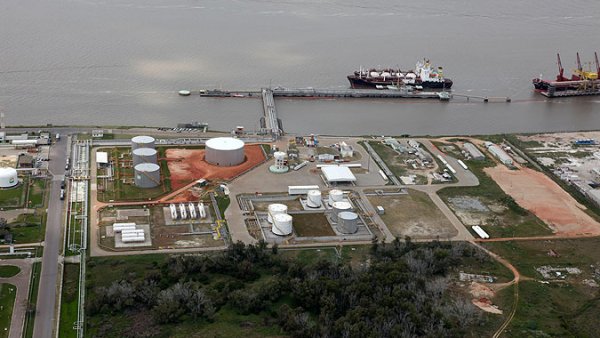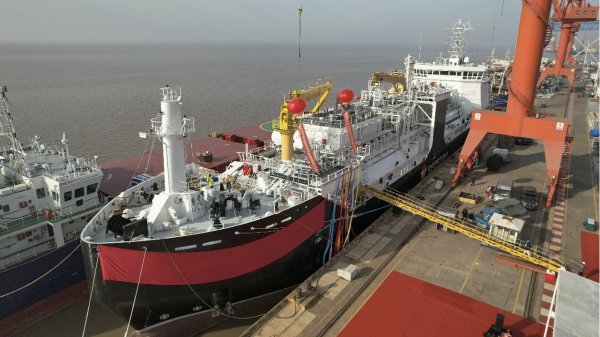Yara Marine scrubbers for four feeder ships
Contract awarded for vessels operated by Jungerhans Maritime Services GmbH.
Oslo-headquartered Yara Marine Technologies has been awarded a contract for the supply of exhaust gas cleaning systems - also known as scrubbers - on four container feeder vessels that are to be operated by German shipmanager Jungerhans Maritime Services GmbH & Co.
The installation of scrubbers aboard the four newbuilds - currently under construction at Zhoushan Changhong International Shipyard co., Ltd in Zhoushan, China - will enable the ships to comply with IMO's new global 0.5% limit on the sulphur content of marine fuel, due to be implemented in January 2020.
Since 2011, Yara Marine says it has designed and contracted more than 100 scrubber systems, with most of them already in operation.
Yara Marine scrubbers are designed to clean fuel with a sulphur content of up to 3.5 percent down to IMO's strict Sulphur Emission Control Area (SECA) requirement of 0.1%.
"All our scrubber systems are also in full compliance with the global 0.5% SOx limit", the company said last week in reference to the implementation of IMO's new worldwide restriction in just over three years' time.
With Yara Marine scrubber system installed, Jungerhans' container feeders can operate on heavy fuel oil (HFO) with a sulphur content up to 3.5% and comply with both today's and future IMO regulations. The new vessels will be fully emission-compliant when using HFO fuel inside the current North European SECA, as well as outside the SECA when the new global regulation becomes effective.
Delivery of the first vessel is expected prior to the fourth quarter of 2017.
In September, Bunker Index reported that Yara Marine had completed the installation of scrubbers aboard Norwegian Cruise Line's (NCL) Norwegian Jewel.
The new lightweight in-line scrubbers are a hybrid technology developed by Yara Marine that are able to operate in dry, open-loop and closed-loop mode. Five scrubbers were installed, one per engine, covering the whole propulsion system. NCL has said the systems are collectively capable of reducing sulphur emissions by up to 99 percent and also reduce particulate emissions by 85 percent.
The installation of scrubbers aboard the four newbuilds - currently under construction at Zhoushan Changhong International Shipyard co., Ltd in Zhoushan, China - will enable the ships to comply with IMO's new global 0.5% limit on the sulphur content of marine fuel, due to be implemented in January 2020.
Since 2011, Yara Marine says it has designed and contracted more than 100 scrubber systems, with most of them already in operation.
Yara Marine scrubbers are designed to clean fuel with a sulphur content of up to 3.5 percent down to IMO's strict Sulphur Emission Control Area (SECA) requirement of 0.1%.
"All our scrubber systems are also in full compliance with the global 0.5% SOx limit", the company said last week in reference to the implementation of IMO's new worldwide restriction in just over three years' time.
With Yara Marine scrubber system installed, Jungerhans' container feeders can operate on heavy fuel oil (HFO) with a sulphur content up to 3.5% and comply with both today's and future IMO regulations. The new vessels will be fully emission-compliant when using HFO fuel inside the current North European SECA, as well as outside the SECA when the new global regulation becomes effective.
Delivery of the first vessel is expected prior to the fourth quarter of 2017.
In September, Bunker Index reported that Yara Marine had completed the installation of scrubbers aboard Norwegian Cruise Line's (NCL) Norwegian Jewel.
The new lightweight in-line scrubbers are a hybrid technology developed by Yara Marine that are able to operate in dry, open-loop and closed-loop mode. Five scrubbers were installed, one per engine, covering the whole propulsion system. NCL has said the systems are collectively capable of reducing sulphur emissions by up to 99 percent and also reduce particulate emissions by 85 percent.

|
IMO approves pricing mechanism based on GHG intensity thresholds
Charges to be levied on ships that do not meet yearly GHG fuel intensity reduction targets. |
|
|
|
||

|
VARO Energy expands renewable portfolio with Preem acquisition
All-cash transaction expected to complete in the latter half of 2025. |
|
|
|
||

|
NYK trials biofuel in milestone coal carrier test
Vessel is used to test biofuel for domestic utility company. |
|
|
|
||

|
H-Line Shipping orders LNG bunkering vessel
Vessel with 18,000-cbm capacity to run on both LNG and MDO. |
|
|
|
||

|
How to engineer and manage green shipping fuels | Stanley George, VPS
Effective management strategies and insights for evolving fuel use. |
|
|
|
||

|
Swedish government bans scrubber wastewater discharges
Discharges from open-loop scrubbers to be prohibited in Swedish waters from July 2025. |
|
|
|
||

|
MAN Energy Solutions achieves 100% load milestone for ammonia engine
Latest tests validate fuel injection system throughout the entire load curve. |
|
|
|
||

|
Petrobras secures ISCC EU RED certification for B24 biofuel blend at Rio Grande
Blend consisting of 24% FAME is said to have been rigorously tested to meet international standards. |
|
|
|
||

|
Stolt-Nielsen to fully control Avenir LNG with acquisition
Share purchase agreement to buy all shares from Golar LNG and Aequitas. |
|
|
|
||

|
Bureau Veritas supports launch of CIMC SOE's LNG bunkering vessel
Handover of Seaspan Energy's cutting-edge 7,600-cbm vessel completed. |
|
|
|
||
Related Links
- · Finnlines profit up on cheaper HFO with scrubbers, lower fuel consumption [Insights]
- · Norwegian Jewel retrofitted with scrubber technology [Insights]
- · Wartsila scrubbers the first to be flag-approved in Asia [Insights]
- · Scrubber producer AEC Maritime teams up with Damen [Insights]
- · Scrubber system for Great Lakes cement carrier [Insights]
- · Norway [Directory]
- · Germany [Directory]

